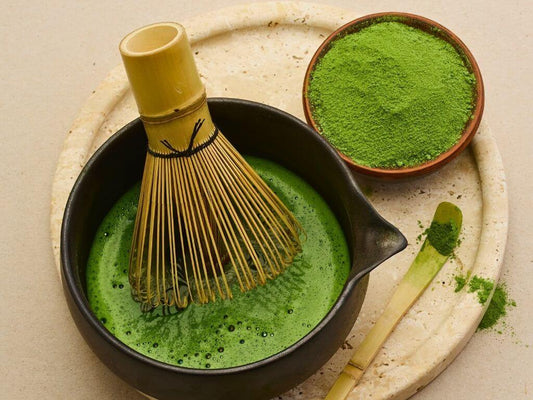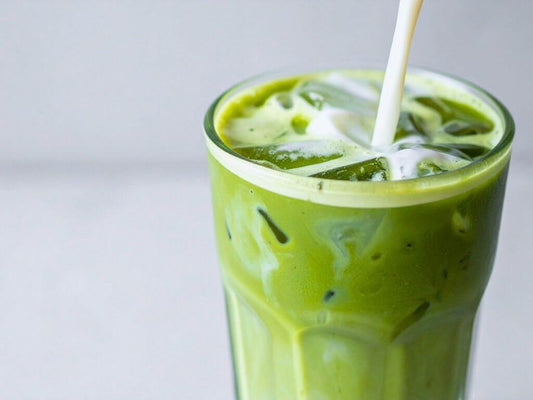If you’re passionate about tea, you’ve probably wondered about the origin of matcha—and why certain grades seem harder to find lately. The answer blends history, terroir, cultivation techniques, and a global demand that keeps climbing. At Nawo Routines, we’ll explain how it all began, what’s happening with supply, and which new regions are emerging to complement the established classics.
From Japanese ceremony to global phenomenon
Talking about the origin of matcha takes us to Zen monasteries and Japan’s first shaded tea gardens. The practice of covering tea bushes weeks before harvest, then steaming and grinding selected leaves into an ultra-fine powder, produced an intense green tea originally intended for the tea ceremony.
Over time, matcha leapt from tatami mats to cafés, creative pastry kitchens, and wellness routines. That expansion multiplied demand—especially for premium and ceremonial grades, which require extreme care and are produced in small batches.
Why there are shortages—and what’s driving them
Understanding the origin of matcha also means recognizing the natural constraints of shaded cultivation. Shading boosts amino acids and umami, but it demands more labor, expertise, and time. Farms with the right soils aren’t limitless, and standardization is complex. Add to that soaring global popularity driving orders from cafés, brands, and home consumers.
The result is a tug-of-war between supply and demand, particularly visible in highly sought-after harvests and artisanal lots. In years with challenging weather, the quality of certain batches can fluctuate—and prices reflect that fragile balance.
New sources gaining ground
When you explore matcha’s origin today, you’ll find countries that—without aiming to replace Japan—are developing their own approaches. Regions with a green-tea tradition have adopted shading techniques, cultivar selection, and stone-milling or carefully calibrated micronization systems. In temperate, mid-altitude climates with rich soils and curious producers, matchas are appearing with distinctive aromatic profiles: more herbal in some cases, more confectionary in others. This diversity doesn’t dilute classic matcha’s identity; it expands it, offering alternatives when the desired grade is hard to secure.
Does quality change when the origin changes?
The debate about matcha’s origin shouldn’t be reduced to a map. Quality depends on tangible factors: shading duration, selection of tender leaves, precise steaming, drying, and fine, low-heat milling to preserve chlorophylls and amino acids. A meticulous producer can achieve remarkable results both inside and outside the reference regions. That said, the sensory profile will vary.
A matcha from a classic terroir may show rounded sweetness and deep umami, while one from a newer source might feel brighter, with notes of fresh grass or gentle cereal. In the end, your choice is about personal style and intended use—sipping straight with water, making a creamy latte, or cooking and baking.
Keys to choosing well in a changing market
When buying, treat origin as a clue—not a final verdict. Start with color: it should be a vivid green, never dull or yellowish. Check the fineness of the powder—it should feel almost silky to the touch—and pay attention to aroma: you’re looking for freshness and sweet notes, not old hay.
If you’ll drink it straight, prioritize ceremonial or premium grades; for lattes or baking, a good culinary grade can deliver excellent performance. Also check the milling or packing date, since freshness matters a lot to the final experience.
When trying new origins, keep an open mind: compare side by side, adjust temperature and ratios, and note what you enjoy most.
Impact on price and sustainability
Matcha’s origin directly affects price because it concentrates artisanal work and select raw material. Small batches, prolonged shading, and slow milling make products more expensive, and temporary scarcity can reinforce that trend.
At the same time, producers are pursuing more sustainable practices—from reusable shading materials to soil management that preserves biodiversity. New origins, when developed with respect for the environment and technique, help ease pressure on saturated areas and foster more resilient local economies.
Looking ahead
Matcha’s origin will continue to mean tradition—but also responsible innovation. Consumer curiosity, brand transparency, and producers’ dedication are shaping a more diverse landscape. For those who value ritual and flavor, that’s good news: more options, more nuance, and more chances to find the cup that fits your day-to-day life.
At Nawo Routines, you’ll find matcha from several origins—but always top quality. Reach out to us anytime; we’ll recommend the right variety for your intended use and personal preferences.



